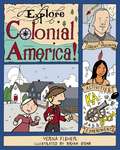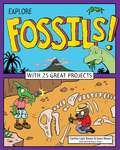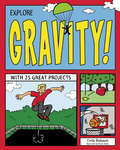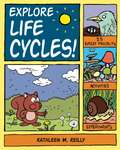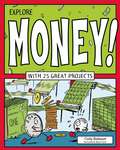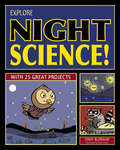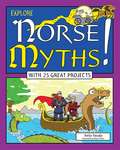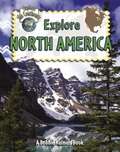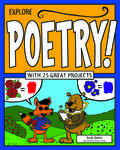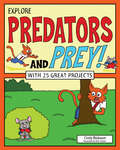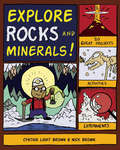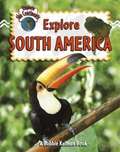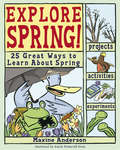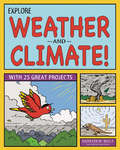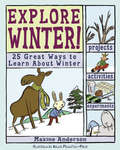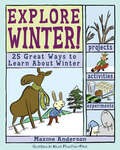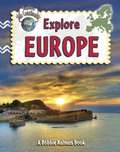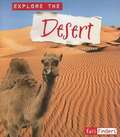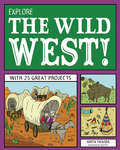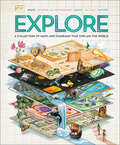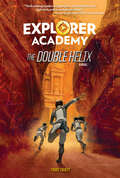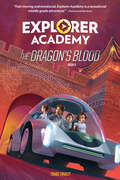- Table View
- List View
Explore Colonial America!
by Verna Fisher Bryan StoneIn Explore Colonial America!, kids ages 6-9 learn about America's earliest days as European settlements, and how the colonists managed to survive, build thriving colonies, and eventually challenge England for independence.How did the colonists build homes, feed and clothe themselves, and get along with the Native Americans who were already here? This accessible introduction to the colonial period teaches young children about the daily lives of ordinary colonists and offers fascinating stories about those who helped shape the emerging nation. Activities range from creating a ship out of a bar of soap and building a log home out of graham crackers and pretzels to making a wampum necklace. Projects are easy-to-follow, require minimal adult supervision, and use primarily common household products and recycled supplies.By combining a hands-on element with riddles, jokes, fun facts, and comic cartoons, kids Explore Colonial America!, and have a great time discovering our nation's founding years.
Explore Fossils!
by Cynthia Light Brown Grace BrownIn Explore Fossils! With 25 Great Projects, readers can expand their dinosaur obsessions into learning opportunities that take them beyond Triceratops, Stegosaurus, and even Tyrannosaurus rex to other animals, plants, and microbes that lived long before humans. Explore Fossils! introduces young readers to the history of life on Earth as revealed by fossils. Kids learn how fossils form and about the different types of fossils and the world of long ago--its landscape and the plants and animals that lived then. Scientists use radiometric dating to test fossils to discover when they were made, what organisms made them, what those organisms used for energy, what killed them, and a whole lot of other information. All from rocks! That's a lot of information stored under our feet. Activities include creating plaster fossils, using popcorn to illustrate radiometric dating, and exploring what might have caused mass extinctions by making a lava flow and simulating an asteroid impact. By studying the past, not only do students meet amazing plants and animals, they are also encouraged to consider their own role in geological time to make thoughtful hypotheses about the future.
Explore Gravity!
by Bryan Stone Cindy BlobaumHow can something that grounds us and keeps us here on this earth be so invisible and mysterious? We're not talking about anything abstract and undetectable. We're talking about GRAVITY! Gravity is a force that affects everyone and everything. Gravity is something we can easily understand, even kids, especially if they have the right tools to teach them.Explore Gravity! With 25 Great Projects will introduce kids ages 6-9 to the basics of gravity, including concepts of matter, attraction, and gravitational pull. Projects include creating a working model of a scale to learn what "weight" really means and how it's affected by gravity. By playing with various weights to make a marvelous mobile, readers learn about the center of balance and how martial artists use this knowledge to throw their weight around. All the projects in this book are easy to follow, require little adult supervision, and use commonly found household products, many from the recycling box! The fun facts, trivia, jokes, comics, and hands-on activities will help kids discover the captivating science of gravity. Furthermore, the informational text and hands-on activities will excite kids about STEM, the interrelated fields of science, technology, engineering, and math.
Explore Life Cycles!
by Kathleen M. Reilly Bryan StoneExplore Life Cycles! takes kids on an amazing journey, where they'll learn about the changes plants and animals experience throughout their lives. Kids ages 6-9 will discover what happens inside those magical cocoons to transform a caterpillar into a butterfly. They'll explore how frogs breathe underwater as tadpoles, then use lungs as an adult. Explore Life Cycles! will examine how plants and animals are born, develop, and live their lives.Activities range from creating edible life cycles of insects to making a mealworm nursery. Using an eye-catching combination of cartoons, fun facts, and exciting projects, Explore Life Cycles! will bring the mysteries of life right into kids' hands.
Explore Money!
by Bryan Stone Cindy BlobaumIn Explore Money! With 25 Great Projects, money is more than something to earn, save, and spend. It's an opportunity to explore history, art, science, economics, and math! While checking out the change in their pockets and bills from their banks, young readers search for hidden treasures, learn how money can multiply, and see how countries keep their currency secure. Very large and very small numbers take on a new relevance when seen through the lens of money. Using familiar materials found in the home or classroom, young readers explore the cultural aspect of money as well as its physical properties, discovering how these properties have affected business and global relationships throughout history. Kids experiment with various substances to clean coins, scientifically test coin components, design their own currency, and plan how to allocate their own money. Understanding the whats, whys, and hows of currency helps children achieve financial literacy and establish a strong foundation for a healthy, life-long relationship with money. Explore Money! meets Common Core State Standards for literacy in language arts, and mathematics; Guided Reading Levels and Lexile measurements indicate grade level and text complexity.
Explore Night Science!
by Bryan Stone Cindy BlobaumExplore Night Science! encourages 6-9 year olds to safely explore and understand what happens around the world when it is dark outside. Readers are led step by step into integrated, active explorations that uncover the science and technology of the natural and physical world that surrounds them. Kids learn about the rod and cone cells found in their eyes as they test their color vision at night, create a chorus mimicking the sounds of nocturnal animals, and make a personal stardome. Sidebars highlight a real kid who discovered a supernova, how Stonehenge is an ancient almanac, and what elephants and moths have in common.Kids will be amazed at the adaptations used by plants and animals to survive and thrive in the dark of night. Whether they live in the country or in the city, kids will learn to use all of their senses to investigate the night.
Explore Norse Myths!
by Anita YasudaThe stories of Norse myths and legends are a terrific introduction to Viking culture, history, science, and traditions, which thrived in Scandinavia from the eighth to the eleventh centuries. But who were the Norse, who left their homelands in Denmark, Norway, and Sweden to trade, raid, and explore around the world? In Explore Norse Myths! With 25 Great Projects, young readers discover the remarkable people and mythical creatures of old. Learning about Norse myths means unearthing the origin of Viking beliefs, as well as exploring their ships, tools, and other technology that flourished for nearly 450 years. Along the way, kids will read how Norse myths helped explain the natural world from thunder to the seasons, from creation to death. They may be surprised at how Norse myths continue to influence modern culture in the form of movies and books, including the new series by Rick Riordan. Readers will read Norse stories and learn about the adventures of real Norse explorers, including Erik the Red and Leif Erikson. Through a mixture of fun facts, trivia, jokes, comics, and hands-on activities, kids will dig up Scandinavia's past and sail the seas along with the gods and giants in Explore Norse Myths!
Explore North America (Explore the Continents)
by Bobbie Kalman Molly AloianThis book explores North America: its geography, people, famous tourist places and other interesting facts.
Explore Poetry!
by Andi DiehnPoems can be silly, serious, or fun, just like kids! Whether it’s the sing-song rhythm of a limerick, the serendipitous magic of a found poem, the deceptive simplicity of a haiku, or the easy familiarity of an acrostic poem, children are charmed by poetry. And what’s more fun than reading poetry? Writing it! In Explore Poetry! With 25 Great Projects children have fun learning about different forms of poetry while delving into different literary techniques such as personification, metaphor, and alliteration, all of which are discussed in a simple and accessible way. Activities include creative writing exercises designed to reinforce language arts skills, plus art projects that encourage children to visualize concepts and definitions. Short biographies of important poets reinforce the concept of poetry as an important part of society. Explore Poetry! meets Common Core State Standards for language arts; Guided Reading Levels and Lexile measurements indicate grade level and text complexity. Informational and inspiring, Explore Poetry! fits seamlessly into the poetry curriculum of grades 2 to 4 and serves as an enrichment resource all during the school year, especially April, Poetry Month.
Explore Predators And Prey
by Cindy BlobaumHunting, hiding, trapping, and tricking are just a few of the strategies used by animals in the wild to ensure they eat enough without being eaten themselves! In Explore Predators and Prey! With 25 Great Projects, readers ages 7 through 10 explore the physical and behavioral adaptations of predators and prey and their impact on the environment. Predators, such as hawks and foxes, have keen eyesight and sharp beaks and teeth to help them catch their prey. Prey, such as mice and rabbits, have large ears to hear danger and can move quickly to escape their enemies. Animal populations are closely integrated with each other and the surrounding environment. A change to one population causes changes to all others. Readers discover how repercussions can affect nature, including humans, and are encouraged to consider their own actions with an eye toward the effect on the environment. In Explore Predators and Prey, kids actively learn about body tools and behavior strategies as they test their own abilities to hunt and hide in a series of science-minded activities. Fun facts and colorful cartoons make learning entertaining and links to online primary sources and videos make the content accessible to all learners.
Explore Predators and Prey!: With 25 Great Projects
by Cindy Blobaum Matt AucoinHunting, hiding, trapping, and tricking are just a few of the strategies used by animals in the wild to ensure they eat enough without being eaten themselves! In Explore Predators and Prey! With 25 Great Projects, readers ages 7 through 10 explore the physical and behavioral adaptations of predators and prey and their impact on the environment.Predators, such as hawks and foxes, have keen eyesight and sharp beaks and teeth to help them catch their prey. Prey, such as mice and rabbits, have large ears to hear danger and can move quickly to escape their enemies. Animal populations are closely integrated with each other and the surrounding environment. A change to one population causes changes to all others. Readers discover how repercussions can affect nature, including humans, and are encouraged to consider their own actions with an eye toward the effect on the environment.In Explore Predators and Prey, kids actively learn about body tools and behavior strategies as they test their own abilities to hunt and hide in a series of science-minded activities. Fun facts and colorful cartoons make learning entertaining and links to online primary sources and videos make the content accessible to all learners.
Explore Rocks and Minerals!
by Cynthia Light Brown Bryan Stone Nick BrownExplore Rocks and Minerals! offers kids ages 6-9 a fascinating introduction to geology. It investigates the geological forces that create and transform rocks, outlining the life cycle of igneous, sedimentary, and metamorphic rocks, and what they can tell us about the earth. It also explores fossils, and how they come to exist and are discovered.Explore Rocks and Minerals! includes 20 hands-on activities to bring learning to life. Kids create their own crystals, sculpt edible models of the planet, and bake volcanic meringue cookies. These easy-to- follow activities require minimal adult supervision and use common household products. By combining an interactive component with jokes, fun facts, and cartoons, Explore Rocks and Minerals! provides a fun, accessible introduction to geology.
Explore South America (Explore The Continents)
by Bobbie Kalman Molly AloianThe world's largest tropical rain forest and the world's longest mountain range are both found on the continent of South America. This beautiful new book introduces children to the fascinating physical and social geography of South America including the continent's countries; major landforms and bodies of water; and people, plants, and animals in the rain forests, grasslands, and deserts.
Explore Spring!
by Lauri Berkenkamp Alexis Frederick-FrostFrom tracking spring peepers and raising tadpoles to learning about seeds and recording plant growth, Explore Spring! 25 Great Ways to Learn About Spring invites young readers to explore the wonders of spring by becoming scientists in the field. Combining hands-on learning with solid science, trivia, riddles, and terrific illustrations, projects investigate "the reason for the season" and include identifying trees and measuring their growth, recording soil temperature, and observing the forest floor. Bird migration and nest building are covered, and the movement of air and water is studied with experiments in capillary action and in such activities as "Making Parachutes," Making Kites," and "Mapping Air Currents with Bubbles."
Explore Weather and Climate!
by Bryan Stone Kathleen M ReilleyWhat's it like outside? And what are you going to do about it?Every morning, before heading to school or out to play, kids want to know what the weather is going to be like that day. Is it a day for building a snowman, constructing a sandcastle, or planting a garden? Will they be stuck inside because of rain at recess? Or stuck at home because of snow? And what about tomorrow? Explore Weather and Climate! will help kids understand the "how" and "why" behind the "what." They'll learn how wind, sun, and water combine to form the weather we experience every day. They'll find out why the weather gets extreme. Explore Weather and Climate! offers engaging text reinforced with 25 hands on projects that include creating a storm in a bottle, touching the clouds, and eating an edible climate map, resulting in an unforgettable understanding of these forces of nature.
Explore Winter!
by Maxine Anderson Alexis Frederick-FrostYoung readers become scientists in the field when this activity book sends them off to answer the question "Why do we have winter?" with experiments and projects that mix real science with real fun. Combining hands-on learning with trivia, jokes, riddles, and terrific illustrations, chapters start with the "tools" of science-the scientific method and how to keep a science journal-and then investigate the winter constellations, long nights and long shadows, animal tracking in snow, and food-gathering behavior in birds.
Explore Winter!: 25 Great Ways to Learn About Winter
by Maxine Anderson Alexis Frederick-FrostYoung readers become scientists in the field when Explore Winter! sends them off to answer the question "Why do we have winter?" with experiments and projects that mix real science with real fun. Combining hands-on learning with trivia, jokes, riddles, and terrific illustrations, chapters start with the "tools" of science-the scientific method and how to keep a science journal-and then investigate the winter constellations, long nights and long shadows, animal tracking in snow, and food-gathering behavior in birds.
Explore the Bible: The Life of Christ Student Textbook
by Purposeful DesignThis book helps students explore Jesus' life through 40 individual lessons incorporated into a student textbook.
Explore the Continents: Explore Europe
by Bobbie Kalman Molly AloianTopics include: the natural border between Europe and Asia; Europe's many peninsulas, mountain systems, and other landforms; how Europe's location on Earth affects the continent's climate; European bodies of water, including seas, lakes, rivers, and bays; and the tundra, steppes, forests, and the living things found in these biomes.
Explore the Desert (Explore the Biomes Ser.)
by Kay JacksonDiscusses the plants, animals, and characteristics of the desert biome.
Explore the Salish Sea: A Nature Guide for Kids
by Joseph K. Gaydos Audrey DeLella BenedictFilled with beautiful photography and engaging text, Explore the Salish Sea inspires children to explore the unique marine ecosystem that encompasses the coastal waters from Seattle's Puget Sound up to the Strait of Juan de Fuca and the Georgia Strait of British Columbia.Discover the Salish Sea and learn about its vibrant ecosystem in this engaging non-fiction narrative that inspires outdoor exploration. Filled with full-color photography, this book covers wildlife habitats, geodiversity, intertidal and subtidal sea life, and highlights what is unique to this Pacific Northwest ecosystem.
Explore the Wild West!
by Bryan Stone Anita YasudaExplore the Wild West! 25 Great Projects, Activities, Experiments invites young readers ages 6-9 to experience the spirit of the Wild West. Kids learn about explorers who mapped the American West, Native Americans, gold miners, cowboy culture, cattle drives, Wild West legends, frontier towns, peacekeepers, lawbreakers, and much more. Through projects ranging from making a settler's soddie to mining for gold, kids develop a better understanding of the rich history of the Wild West in the 1800s.
Explore: A Collection of Maps and Diagrams That Explain the World (Explore)
by DKThis book of maps helps you navigate the big topics that explain the world: science, history, nature, and space.Maps can help you find your way around more than just places, and knowledge can be shared using more than just words. Using maps, children aged 7-9 will be introduced to need-to-know topics in an inviting and visual way.Explore is a new and exciting style of reference that’s packed with diagrams and information to explain each map to inquisitive children. Inside, you’ll find a whole collection of maps to pore over on subjects you’d never expect, from cells and our planet to amphibians and microscopic life.This all-encompassing maps book for children offers: An all-new visual approach to learning core subjects, as part of a brand new exciting reference series.A combination of maps and other diagrams that break down important topics, combined with stats, facts, figures, and explanations.Bright and stand-out illustrations from the award-winning Studio Muti that explore each topic.Follow the routes of animals as they embark on migrations and of seeds as they leave their parent plants. Discover maps to guide you around hidden spaces, like the inside of a beehive, and places as distant as the outer reaches of the solar system. Explore the depths of the ocean, a single cell, a car engine, the human brain, a medieval castle, and much more. This unique book features an encyclopedic range of subjects for children who want to find out everything there is to know about the world.
Explorer Academy: The Double Helix (Explorer Academy)
by Trudi TrueitThe mystery deepens and the action intensifies for 12-year-old Cruz Coronado and friends in the exciting third book in the Explorer Academy series.The adventure continues for Cruz, Emmett, Sailor, and Bryndis as they continue their studies at sea and travel to exotic locations around the world. A mysterious person alerts Cruz to impending danger while he and a few trusted pals explore ancient ruins in Petra, Jordan, and search for another piece of the puzzle his mother left behind. Worst of all, now his father has gone missing, which prompts Aunt Marisol, his number one protector, to leave the ship in search of him. Who is the new professor who takes her place? How does the new technology he introduces help or hurt Cruz's quest? Why is Nebula determined to stop Cruz before he turns 13? The clock is ticking as his first teen birthday draws near ... a milestone that will change his life forever, one way or another.
Explorer Academy: The Dragon's Blood (Explorer Academy)
by Trudi TrueitAn explosive revelation and a familiar face in the sixth book in this adventure-packed series. Still reeling from the life-changing discovery he found buried in the mysterious archive, Cruz Coronado grapples with an important secret as the gang heads to China in search of the second-to-last piece of the cipher. Under the watchful eye of a new adviser, life on the ship returns to almost normal...Almost. Just as things seem to be going smoothly, a familiar face shocks Cruz back into reality, and the final piece in this life-and-death scavenger hunt veers toward a dead end. Explorer Academy features: Gripping fact-based fiction plot that inspires curiosity with new technology and innovations; Amazing inventions and gadgets; A cast of diverse, relatable characters; Secret clues, codes, and ciphers to track down within the text; Vibrant illustrations, Elements of STEAM; National Geographic explorer profiles in The Truth Behind Section. Complete your collection with: The Nebula Secret (1) The Falcon's Feather (2) The Double Helix (3) The Star Dunes (4) The Tiger's Nest (5) Explorer Academy Code-Breaking Adventure Explorer Academy Ultimate Activity Challenge Explorer Academy Field Journal Explorer Academy Future Tech
